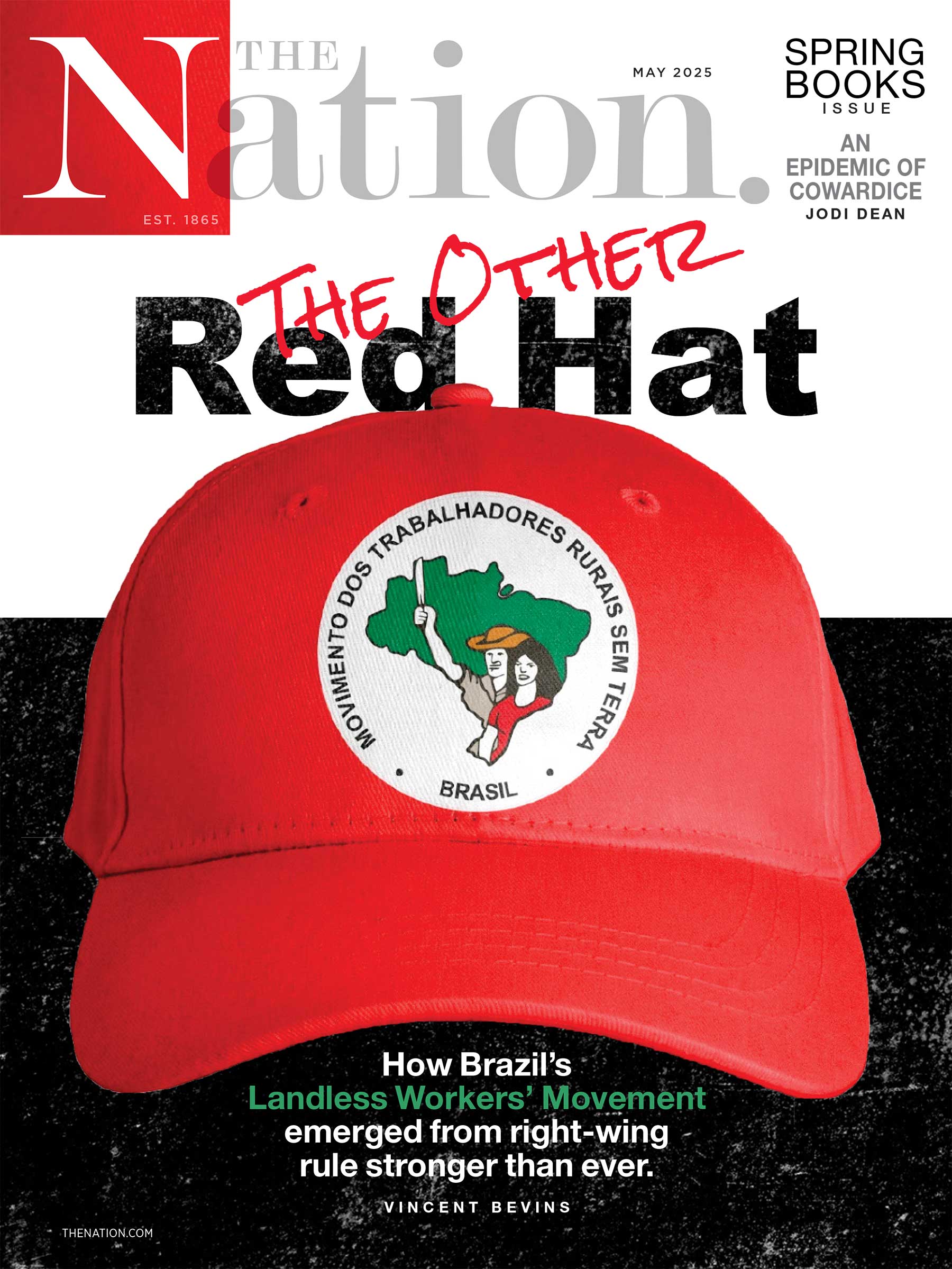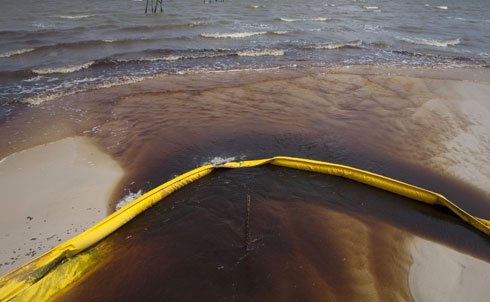
In the aftermath of the April 2010 explosion on BP’s Deepwater Horizon oilrig, the media was saturated with images of oil-streaked Gulf Coast water and birds coated in a toxic mix of petroleum and dispersant. But as Naomi Klein writes in “The Search for BP’s Oil,” when “the spill-cam was switched off and it became clear that there would be no immediate mass die-offs among dolphins and pelicans… most of us were pretty much on to the next telegenic disaster.” When Klein visited the Gulf in early December aboard the research vessel Weatherbird II, however, the very real—if harder to spot—effects of the spill were still being felt.
Credit: Reuters Pictures
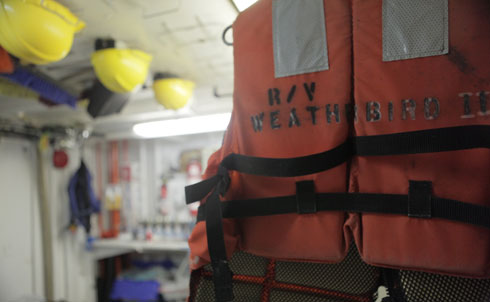
In fact, as Klein found, the most damaging consequences of the spill may be still to come. “For the scientists aboard the WeatherBird II,” Klein writes,“the recasting of the Deepwater Horizon spill as a good-news story about a disaster averted has not been easy to watch."
Over the past seven months, they have seen things that they describe as unprecedented. "Among their most striking findings are graveyards of recently deceased coral, oiled crab larvae, evidence of bizarre sickness in the phytoplankton and bacterial communities, and a mysterious brown liquid coating large swaths of the ocean floor, snuffing out life underneath. All are worrying signs that the toxins that invaded these waters are not finished wreaking havoc and could, in the months and years to come, lead to consequences as severe as commercial fishery collapses and even species extinction.”
Credit: Jacqueline Soohen and Big Noise Films
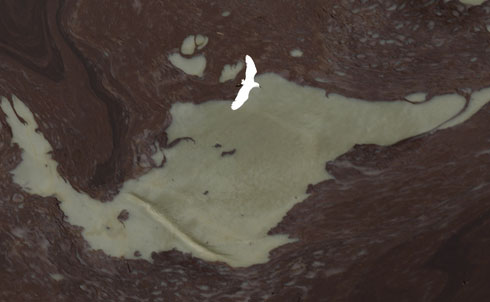
Over the three months before the BP well was capped, at least 4.1 million barrels of oil and 1.8 million gallons of dispersants flowed into the Gulf. It takes time for the ocean to break down that amount of poison, and before that could happen, those toxins came into direct contact with all kinds of life forms. Most of the larger animals—adult fish, dolphins, whales—appear to have survived the encounter relatively unharmed.
But there is mounting evidence that many smaller creatures—bacteria, phytoplankton, zooplankton, multiple species of larvae, as well as larger bottom dwellers—were not so lucky. These organisms form the base of the ocean’s food chain, providing sustenance for the larger animals, and some grow up to be the commercial fishing stocks of tomorrow. One thing is certain: if there is trouble at the base, it won’t stay there for long.
Credit: AP Images
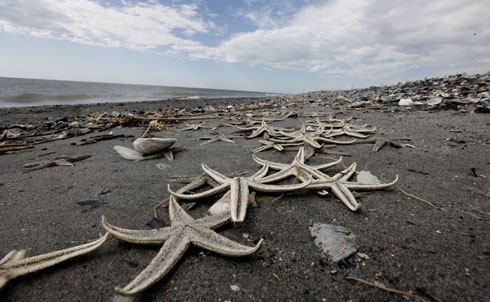
Already there is convincing evidence of at least one significant underwater die-off. In November Penn State biologist Charles Fisher led a NOAA-sponsored expedition that found colonies of ancient sea fans and other coral coated in brown sludge, 1,400 meters down. Nearly all the coral in the area was “dead or in the process of dying,” Fisher told me. And he echoed something I have been hearing from many other scientists: in a career of studying these creatures, he has never seen anything like this. There were no underwater pools of oil nearby, but the working theory is that subsea oil and dispersants must have passed through the area like some kind of angel of death.
Credit: AP Images
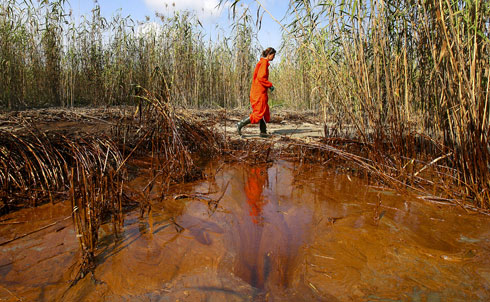
We may never know what other organisms were trapped in a similarly lethal cloud, and that points to a broader problem: now that we are beyond the oil-covered-birds phase, establishing definitive links between the spill and whatever biogenetic or ecological disturbances are in store is only going to get harder. For instance, we know the coral died because of all the bodies: ghostly coral corpses litter the ocean floor near the wellhead, and Fisher is running tests to see if he can find a definitive chemical link to BP’s oil. But that kind of forensics simply won’t be possible for the much smaller life forms that are even more vulnerable to BP’s toxic cocktail.
Credit: Reuters Pictures
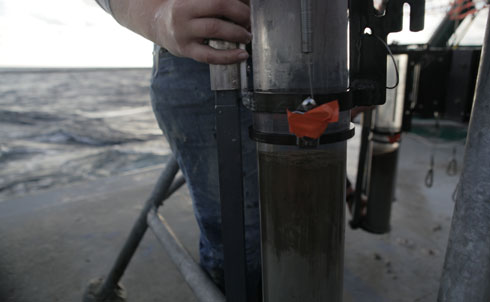
On day three of my cruise with the WeatherBird II, things start to get interesting. We are now in the DeSoto Canyon, about thirty nautical miles from the wellhead. The ocean floor is 1,000 meters down, our deepest station yet. Another storm is rolling in, and as the team pulls up the multi-corer, waves swamp the deck. It’s clear as soon as we see the mud that something is wrong. Rather than the usual gray with subtle gradations, the cylinders are gray and then, just below the top layer, abruptly turn chocolaty brown. The consistency of the top brown layer is kind of fluffy, what the scientists refer to as “flocculent.”
Credit: Jacqueline Soohen and Big Noise Films
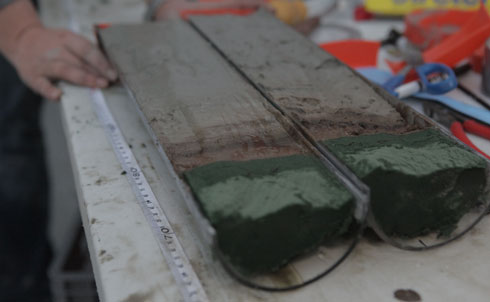
A grad student splits one of the cores lengthwise and lays it out on deck. That’s when we see it clearly: separating the gray and brown layers—and looking remarkably like chocolate parfait—is a thick line of black gunk. “That’s not normal,” marine geochemist David Hollander declares.
Credit: Jacqueline Soohen and Big Noise Films
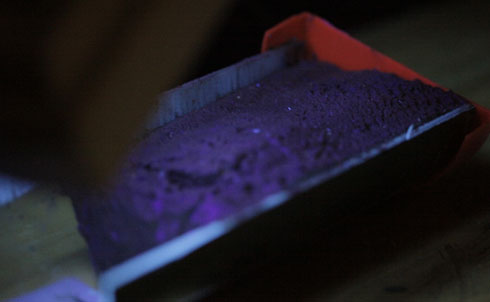
Hollander grabs the mud samples and flags Charles Kovach, a senior scientist with the Florida Department of Environmental Protection. They head to the darkest place on the boat—one of the tiny sleeping quarters crammed with bunk beds. In the pitch darkness they hold an ultraviolet light over the sample, and within seconds we are looking at silvery particles twinkling up from the mud. This is a pretty good indication of oil traces. Hollander saw something similar on the August cruise and was able not only to identify hydrocarbons but to trace them to BP’s Macondo well.
Credit: Jacqueline Soohen and Big Noise Films
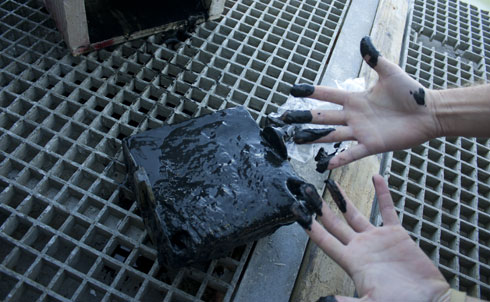
At several more research stations near BP’s wellhead, the WeatherBird II finds the ocean floor coated in similar muck. The closer the boat gets to the wellhead, the more black matter there is in the sediment. And Hollander is disturbed. The abnormal layer of sediment is up to five times thicker than it had been when he collected samples here in August. The oil’s presence on the ocean floor didn’t diminish with time; it grew. And, he points out, “the layer is distributed very widely,” radiating far out from the wellhead.
Credit: Brian Zelinski
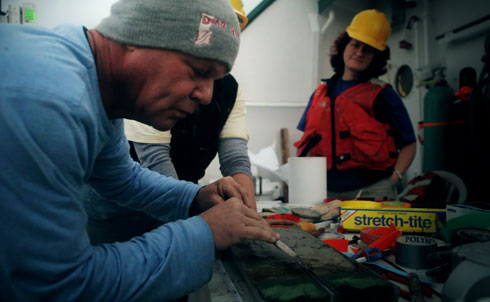
But what concerns Hollander even more are the thick black lines. “That black horizon doesn’t happen,” he says. “It’s consistent with a snuff-out.” Healthy sea-floor mud is porous and well oxygenated, with little critters constantly burrowing holes from the surface sand to the deeper mud, in the same way that worms are constantly turning over and oxygenating soil in our gardens. But the dark black lines in the sediment seemed to be acting as a kind of sealant, preventing that flow of life. “Something caused an environmental and community change,” Hollander explains. It could have been the sheer volume of matter falling to the bottom, triggering a suffocation effect, or perhaps it was “a toxic response” to oil and dispersants.
Credit: Jacqueline Soohen and Big Noise Films
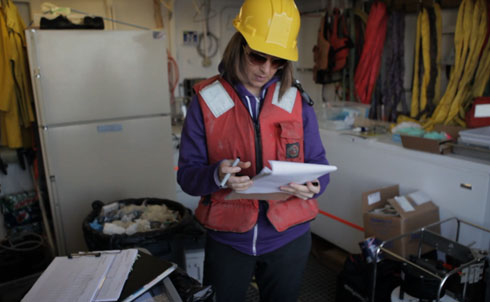
One of the things I am learning aboard the WeatherBird II, watching these scientists test for the effects of invisible oil on invisible organisms, is not to trust my eyes. For a few months last year, when BP’s oil formed patterns on the surface of these waters that looked eerily like blood, industrial society’s impact on the ocean was easy for all to see. But when the oil sank, it didn’t disappear; it just joined so much else that the waves are hiding, so many other secrets we count on the ocean to keep. Like the 27,000 abandoned oil and gas wells in the Gulf of Mexico, and the network of unmonitored underwater pipelines that routinely corrode and leak. Like the sewage that cruise ships are entirely free to dump, under federal law, so long as they are more than three miles from shore. Like a dead zone the size of New Jersey. And on and on. The ocean’s capacity to heal itself from our injuries is not limitless. Yet the primary lesson being extracted from the BP disaster seems to be that “mother nature” can take just about anything we throw at her.
Read Naomi Klein’s full report from the Gulf, “The Search for BP’s Oil,” and watch a video of the findings of the WeatherBird II.
Credit: Jacqueline Soohen and Big Noise Films
